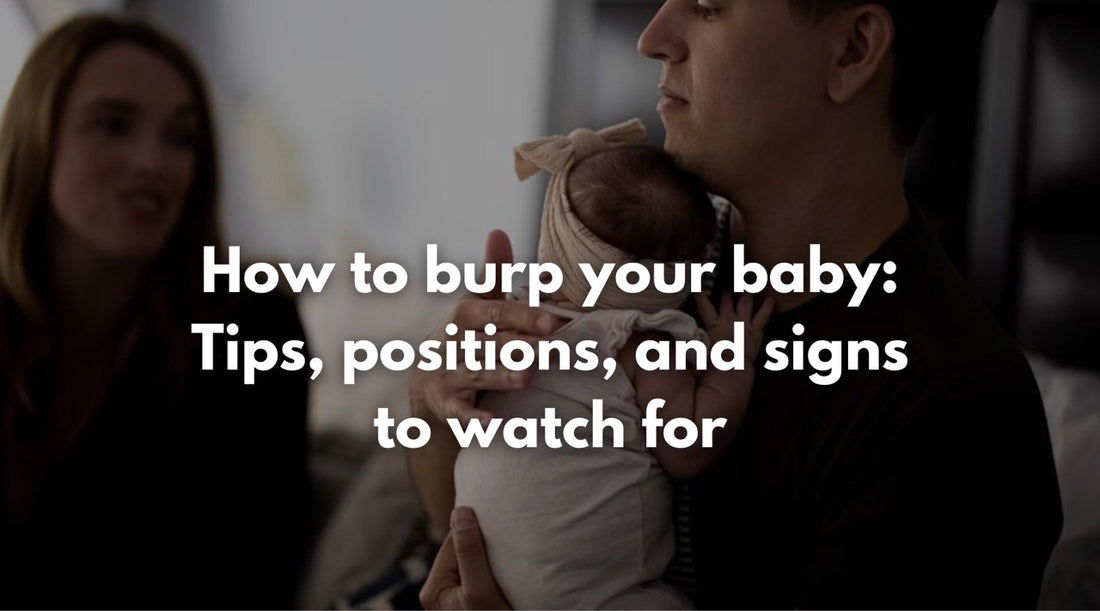
How to burp a baby: tips, positions, and signs to watch for
Share
Some babies bring up a burp with almost no help, while others need a little extra support to release swallowed air. There’s no single “correct” method—what matters most is finding a technique that feels comfortable for both you and your little one.
Why burping a baby matters
Feeding and breathing at the same time means babies often swallow air. If that air isn’t released, it can become trapped and lead to discomfort, fussiness, or gas pains. Helping your baby burp after feeds—especially before sleep—reduces the chance of trapped wind and helps them settle more easily.
Burping a sleeping baby
Even if your baby drifts off during a feed, try to burp them before laying them down. Hold them upright with their head higher than their tummy to make it easier for air to escape. During nighttime feeds, always include a quick burping routine. If you put your baby down and they start to squirm, arch their back, clench their fists, or cry, gently pick them up and try again. Keep a burp cloth handy for any spit-up so you won’t need to change their clothes in the middle of the night.
Signs it’s time to burp
-
Feeding is complete. Most babies need just a few minutes of gentle burping after each feed. Some will need a little longer—every baby is different.
-
Signs of discomfort. If your baby squirms, pulls away, or makes unusual faces mid-feed, pause for a burping break.
-
Gassy tendencies. If your baby is prone to gas or reflux, it can help to pause for a burp during the feed, not just after.
Three classic burping positions
For all techniques, always support the baby’s head and neck and keep their back straight. Hold their chin, not their throat. The goal is a successful burp.
Over the shoulder : place your baby against your chest so their chin rests on your shoulder. Gently rub or pat their back. Some parents like to walk or rock while doing this to encourage a burp.

Sitting on your lap: sit your baby upright on your lap, leaning them slightly forward. Support the chin with one hand and gently pat or rub the back with the other. This is an effective way to burp a baby.

Lying across your lap: lay your baby face-down across your lap, making sure the head is slightly higher than the chest and the airway is clear. Rub or pat their back lightly.

Helpful tips and tricks
-
Keep it brief. A few minutes of burping after each feed is usually enough.
-
Have a cloth ready. Spit-up is normal—protect your clothes and theirs.
-
Switch it up. If one position isn’t working, try another for burping a baby.
-
Pause during feeds for gassy babies. If your baby is very gassy, has reflux, or spits up often, burping more frequently can help—such as after every couple of ounces or when switching breasts.
When your baby won’t burp
If a burp doesn’t appear right away:
-
Try a different burping position.
-
Give it a little more time—some babies just take longer.
-
If your baby still seems uncomfortable or fussy, continue gentle attempts until the trapped air escapes.
Key takeaways
Burping a baby helps release swallowed air and prevents discomfort. Aim to burp after every feed—especially before bedtime. Signs that it’s time include finishing a feed, showing signs of discomfort, or a tendency toward gassiness. Use whichever position works best—over the shoulder, sitting on your lap, or lying across your lap—and keep a burp cloth handy. If one method doesn’t work, simply try another until your baby feels more comfortable. The goal is a successful burp.
